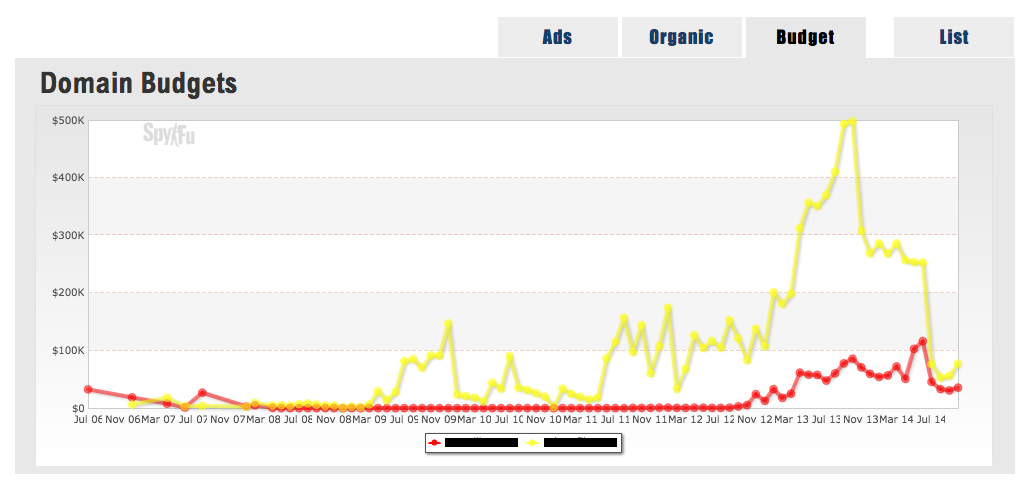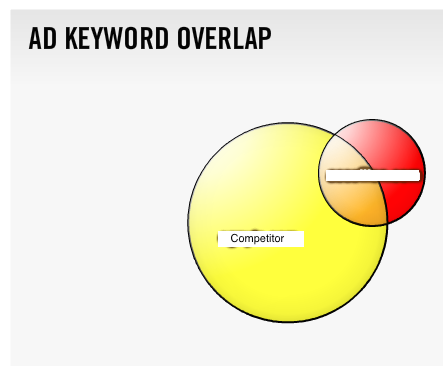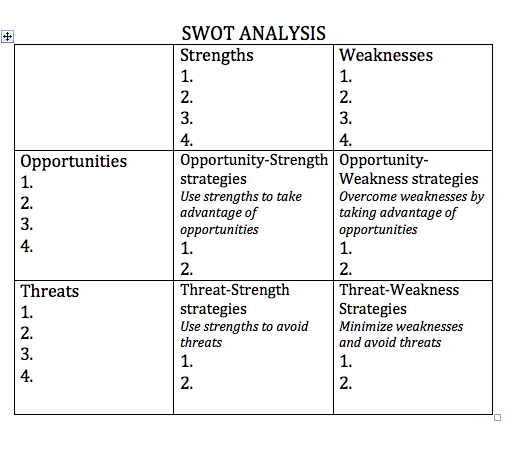When it comes to PPC advertising, I’ve never heard of a business that isn’t interested in what their competitors are doing. Your client might come to you and request a competitive analysis, and you might be wondering where the heck to start. Don’t worry, I’ll walk you through what to look at, how to make the comparisons, and what tools to use.
Choosing Competitors
I recommend taking a look at Auction Insights within the AdWords interface to see what other companies are bidding on the same keywords and what their impression share / average position looks like. This is a great place to start if you’re not sure which competitors you should be looking at.
Takeaways:
- Look for domains that have a higher impression share, or appear above you at a higher rate
Budgets
I like to start off comparing budgets between my client and the competitor. SpyFu is a great tool to use, as it shows budgets over time.
Takeaways:
- How much are they spending?
- How has their budget changed over time? Did they recently ramp up spend, or pull back a ton?
- Think of potential reasons they might be pulling back. Seasonality could be involved, or the business might be pulling out of the PPC landscape
- Should you consider increasing or decreasing budget?
Keywords
When it comes to keywords we can look into both the volume of overlapping keywords, and which keywords they are bidding on specifically. To do this, you can use SpyFu or SEMRush.
Takeaways:
- Are your competitors bidding on terms that you aren’t (but should be)?
- Does your competitor’s keyword reach far surpass your own?
Ad Copy
Ad copy is an important factor for staying competitive within your industry. Your ads are the first thing users see when they type in their search query, and it might be the first time they are introduced to your brand. Make a good impression. See what your competitors are doing, so you can stay competitive.
To compare ad copy, you can use Google (beware of racking up a lot of impressions for your client), Keyword preview tool, SpyFu, or SEMRush.
Takeaways:
- What extensions are your competitors using? Are you using them?
- What are your competitors offering, and how does it compare to your offer?
- Ex: A free trial vs. a demo, free shipping vs. money back guarantee
Landing Pages
Landing pages are also critical to a successful PPC campaign. You can do everything you possibly can to get users to click on your ad, but if your landing page is terrible you’ll lose them anyway. In order to compare landing pages, you’re going to have to spend some time on competitor sites.
Takeaways:
- Congruency: how well does the competitor’s landing page line up with the messaging on the ad copy?
- Layout: how does their layout compare to yours?
- Ex: length and positioning of form, how much text, etc
- Value proposition: does the page have a clear and easy to read value proposition? If so, what is it? How does this compare to yours?
Putting It All Together
Once you’ve finished combing through competitor ads and websites, and have used up your free trial of SEMRush, it’s time to put it all together. The goal here is to make it as clear as possible to your client how you stack up against the competition.
To do this, I recommend putting together a slide deck with a section for each category mentioned above. Each slide should outline what that particular competitor is doing, followed by a takeaway slide for each category. It would look something like this:
Budgets
- Your Client
- Competitor 1
- Competitor 2
- Takeaways
Keywords
- Your Client
- Competitor 1
- Competitor 2
- Takeaways
You get the idea.
Another approach would be to complete a SWOT analysis for each competitor. SWOT stands for Strengths, Weaknesses, Opportunities, and Threats.
Once you come up with a list of all of the above categories for both your client and the competitor, then you can come up with some strategies to gain more competitive advantage.
This framework will help you use your strengths and weaknesses to come up with strategies to position yourself above the competition.







